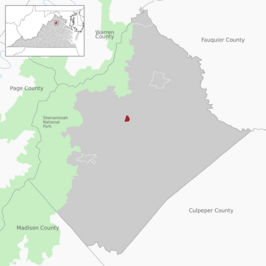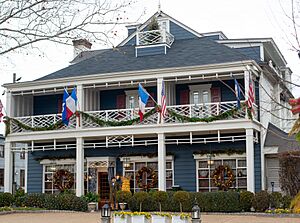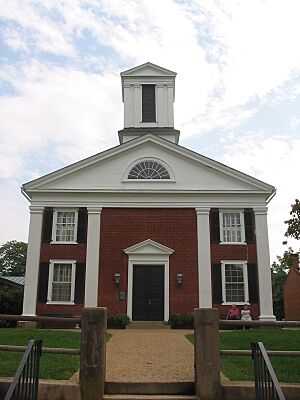Washington, Virginia facts for kids
Quick facts for kids
Washington, Virginia
|
|
|---|---|
|
Town
|
|

Location of Washington within Rappahannock County
|
|
| Country | United States |
| State | Virginia |
| County | Rappahannock |
| Established as a town by the Virginia General Assembly | 1796 |
| Named for | George Washington |
| Government | |
| • Type | Mayor and Town Council |
| Area | |
| • Total | 0.26 sq mi (0.68 km2) |
| • Land | 0.26 sq mi (0.68 km2) |
| • Water | 0.00 sq mi (0.00 km2) |
| Elevation | 682 ft (208 m) |
| Population
(2020)
|
|
| • Total | 86 |
| • Density | 331/sq mi (126.5/km2) |
| Time zone | UTC−5 (Eastern (EST)) |
| • Summer (DST) | UTC−4 (EDT) |
| ZIP code |
22747
|
| Area code(s) | 540 |
| FIPS code | 51-83248 |
| Website | Official Website: http://washingtonva.gov |
Washington, Virginia, is a small, historic town. It is nestled in the eastern foothills of the Blue Ridge Mountains. You can find it close to Shenandoah National Park. The entire town is recognized as a historic district. This means it has many old and important buildings. Washington is also the county seat of Rappahannock County, Virginia.
The town was officially created by the Virginia General Assembly in 1796. It became the county seat for Rappahannock County in 1833. In 1894, Washington became an incorporated town. This means it got its own local government. The town was rechartered in 1985. A big part of the town is called the Washington Historic District. It was added to the Virginia Landmarks Register and the National Register of Historic Places in 1975. People think it's the best-preserved county-seat town in the Piedmont area.
Washington is led by a Town Council with seven members. This includes a mayor, a treasurer, and five other members. They all serve for four years. The famous Inn at Little Washington is located here. The town has a mix of open spaces, homes, shops, and historic buildings. It also offers cultural activities and local government services. In 2020, 86 people lived in Washington. The town covers about 182 acres.
Contents
History of Washington, Virginia
Early Land Grants and Ownership
The first official paper about the land that became Washington was from 1735. King George II of Great Britain gave 1,750 acres to Thomas, James, and Elizabeth Kennerly. This land was in what was then Orange County. They received it for bringing six people to Virginia. They also paid some money and a small yearly fee. At this time, there were very few Native Americans in the area. This made it easy for English settlers to move into the Piedmont region of Virginia.
In 1745, the Kennerly family divided their land into three parts. Thomas Kennerly got the middle part. This section was next to the Rush River and included the future town of Washington. Thomas sold his land to Henry Gambill in 1753. Gambill then divided the land again. In 1754, he sold the western part to John Minor. This part became the western side of Washington. In 1761, he gave the eastern part to his son, William Gambill. This became the northeastern part of the town. The line between these two parts later became part of the road to Chester Gap. It is now Gay Street in Washington.
Over the next 30 years, these two land sections were bought and sold many times. By the 1790s, four important people owned the land. In 1791, William Porter received 247 acres of the western land. In 1795, George Calvert bought 230 acres of the eastern land next to it. Between 1792 and 1795, Porter sold small pieces of his land. He sold 2 acres to James Wheeler, 2 acres to James Jett Jr., and 6 acres to George Calvert. All these pieces were on land that became the town of Washington. Only a few buildings were mentioned in these sales. These included Wheeler's storehouse, Jett's store, and a schoolhouse. They were all located along the road to Chesters Gap. The rest of the land was mostly farmland.
Founding the Town of Washington
On November 1, 1796, George Calvert, James Jett Jr., and James Wheeler asked the Virginia General Assembly to create a town. They wanted to name it Washington. It would be built on 25 acres of their land. The General Assembly agreed on December 14, 1796. They passed a law creating 13 new towns in Virginia, and Washington was one of them.
A year later, Calvert, Jett, Wheeler, and William Porter sent another request. They asked the General Assembly to add some of Porter's land to the town. They included a map of the new streets and lots. Four of the six streets were named after the four men who asked for the town to be created. On December 25, 1797, the General Assembly approved this request.
There's a local story that George Washington himself surveyed and designed the town in 1749. However, this story is believed to come from made-up documents from 1932.
Growth and Development
The people in charge of the new town of Washington quickly started selling the 51 lots. In 1803, Mrs. Anne Cox established a tavern in the town center. This building is still there today. It is now part of the gift shops for The Inn at Little Washington. Mary Resor also opened a tavern on Gay Street. This building later became a home called "Avon Hall."
The Washington post office was set up in the town by 1804. It is still in the town today. The town became known as "Little Washington" as early as 1804. This helped people tell it apart from the new capital, Washington, D.C., which was about 70 miles away.
In 1833, Rappahannock County was formed from part of Culpeper County. The town of Washington was chosen to be its county seat. The courthouse and Court Clerk's office were built by Malcolm F. Crawford in 1833-1834. The jail was built by John W. Fant between 1833 and 1836. A group of seven trustees governed the town. As Washington grew as the center of government, new homes and businesses were built. Two private schools were also created before public education started in Virginia.
Several churches were built in Washington:
- Washington Presbyterian church (1856–1858)
- Trinity Episcopal church (1857)
- Washington Baptist church (1875)
- The African American First Baptist church (1881)
- Washington Methodist church (1890)
The Blue Ridge Guide newspaper served the town and county from 1886 to 1936.
In 1894, the Virginia General Assembly officially incorporated the town. A council of seven members took over governing the town. The Rappahannock National Bank opened in 1903. Electricity and telephones arrived in the 1920s. Thornton's garage was built in the middle of town. This building later became The Inn at Little Washington in 1978. Other stores like Partlow's General Store, Stuart's merchandise store, and Lea Brothers Store opened in the early 1900s.
A new water system was built in the mid-1930s. This was part of Franklin Roosevelt's Works Progress Administration. A volunteer fire department was also created then. In the late 1930s, tourists started visiting the town. They were often on their way to Skyline Drive in Shenandoah National Park.
A big change happened in the mid-20th century. Seven women were elected to the Town Council, replacing the seven men. This made national news, and the town was even called "She-town" for a while. These women did a lot to improve the town. Over the next 50 years, tourism helped the town grow. Many new stores, art galleries, restaurants, and places to stay overnight opened. The weekly Rappahannock News newspaper also started. Two performance arts theaters and a public library were established.
In 1975, Washington was listed on the National Register of Historic Places as the "Washington Historic District." The Town Council then created a review board. Its job was to protect the town's historic look.
The Inn at Little Washington

One of the most important events in the town's recent history was the opening of The Inn at Little Washington in 1978. This restaurant and inn is now famous around the world. It is part of a group of luxury hotels called Relais & Châteaux. It was the first inn to get the Mobil Travel Guide's 5-Star award. It has also received 5 diamonds from the American Automobile Association for its restaurant and lodging for 28 years.
In 2001, Patrick O'Connell, the Inn's owner and chef, won the "Outstanding Chef in America Award." A French guide called La Liste ranked the Inn as the fifth-best restaurant in the world. The Inn attracts many wealthy visitors from Washington, D.C., and nearby areas. Because of the Inn, the town also has several art galleries, unique shops, bed and breakfasts, and other restaurants. People who love art, history, and hiking come to the county for day trips or camping.
In 1985, the Virginia General Assembly gave the town a new charter. This gave Washington more power and responsibilities. Washington has become a safe and quiet community. It is surrounded by the farms of Rappahannock County. The town still has the same street layout and names from its 1797 plan. However, the original 51 lots have been divided into many smaller ones. The town's boundaries have also grown a lot. It started at 25 acres and is now over 182 acres. Washington does not have any large businesses or heavy industry. It is governed by a 7-member Town Council. They follow the town's plan, zoning rules, and local laws.
Washington Historic District
|
Washington Historic District
|
|
| Location | Town of Washington, Virginia |
|---|---|
| Area | 180 acres (73 ha) |
| Built | Circa 1800 to 1945 |
| Built by | Malcolm F. Crawford, James Leake Powers, multiple other builders |
| Architectural style | Early Republic, Greek Revival, Jeffersonian, multiple other styles |
| NRHP reference No. | 75002033 |
| Significant dates | |
| Added to NRHP | May 28, 1975; amended November 21, 2006 |
The "Washington Historic District" was added to the Virginia Landmarks Register and the National Register of Historic Places in 1975. This historic district includes the entire town, which is about 180 acres. Most of the old buildings are in the original 30-acre core of the town. This core was set up in 1796–1797 by George Calvert, James Jett Jr., James Wheeler, and William Porter.
At that time, the Town Council passed a special law called the Historic District Ordinance. This law created a Historic District Architectural Review Board. This board's job is to protect and preserve the town's historic look. Many properties in the town are considered important to its history.
A new survey of the town was done in 2004–2005. In 2006, a change was made to the historic district's rules. It extended the period of historic importance to 1945. This change was recorded on both the Virginia Landmarks Register and the National Register in 2006. A total of 159 properties are now considered to add to the historic nature of the District. Many of the homes and other buildings from the town's earliest days are still standing today.
Important Historic Buildings
The most important landmark is the Rappahannock County Courthouse. It's a two-story building built in 1834–1835. It has a special brick pattern called Flemish bond. Malcolm F. Crawford built it. He also worked on the University of Virginia and built other courthouses. Crawford also built the office next to the courthouse, which is now the Commissioner of Revenue's office.
Other brick buildings in the courthouse area include:
- The county jail (1835–1836)
- The county treasurer's office (1857)
A small wooden building from 1857 was once the office for the Commonwealth Attorney.
Other notable buildings in town include:
- The tavern and inn first owned by Anne Coxe (around 1800), now shops.
- A log building that might be one of the first homes built when the town started in 1796–1797.
- The Trinity Episcopal church (1857) and the Presbyterian church (1858), now the Town Hall.
- The brick Baptist church and Masonic hall (1875).
- A brick bank building (1915), now commercial offices.
Many private homes are also part of the Washington Historic District. These include large homes like:
- Avon Hall (around 1810)
- The Meadows (around 1790)
- Mount Prospect (1872)
- The Maples (around 1850), now a bed and breakfast.
- The home built for Edward Pendleton (around 1800), now lodging for The Inn at Little Washington.
Many other privately owned homes in the district also have historical importance. The town of Washington is often called one of the best-preserved county seat communities in the Virginia Piedmont.
Geography and Location
Washington is located at 38°42′46″N 78°9′34″W / 38.71278°N 78.15944°W.
The town covers a total area of about 0.284 square miles (0.736 square kilometers). Almost all of this area is land, except for a pond at Avon Hall.
The town is on the eastern side of the Blue Ridge Mountains. It is also near the northern part of Shenandoah National Park.
| Historical population | |||
|---|---|---|---|
| Census | Pop. | %± | |
| 1880 | 254 | — | |
| 1890 | 252 | −0.8% | |
| 1900 | 300 | 19.0% | |
| 1910 | 235 | −21.7% | |
| 1920 | 233 | −0.9% | |
| 1930 | 250 | 7.3% | |
| 1940 | 245 | −2.0% | |
| 1950 | 249 | 1.6% | |
| 1960 | 255 | 2.4% | |
| 1970 | 189 | −25.9% | |
| 1980 | 247 | 30.7% | |
| 1990 | 198 | −19.8% | |
| 2000 | 183 | −7.6% | |
| 2010 | 135 | −26.2% | |
| 2018 (est.) | 125 | −7.4% | |
| U.S. Decennial Census | |||
Highways and Roads
The main road that goes through Washington is U.S. Route 211 Business/U.S. Route 522 Business. This road follows Warren Avenue, Middle Street, and Main Street in town. It used to be the main U.S. Route 211, but now that highway goes just southeast of the town.
Using US 211 and US 522, you can reach several other towns:
- Luray to the west
- Culpeper to the south
- Warrenton to the east
- Front Royal to the north
Images for kids
See also
 In Spanish: Washington (Virginia) para niños
In Spanish: Washington (Virginia) para niños








